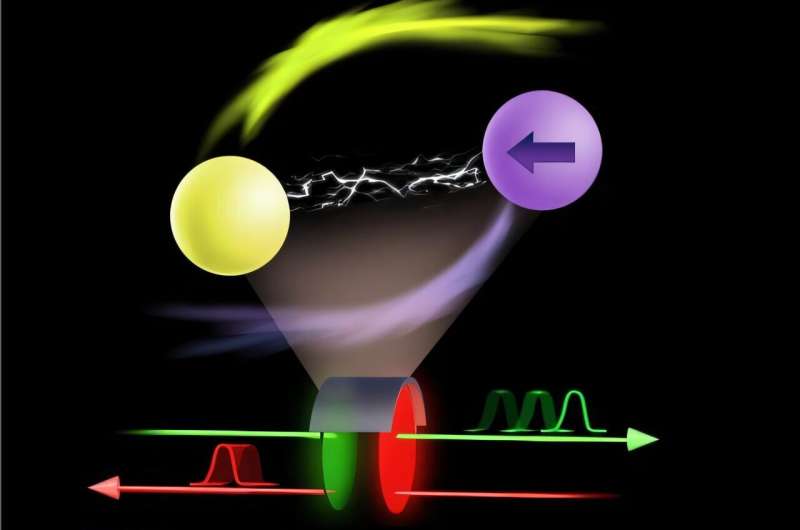
Imagine you’re standing on a road where cars drive in both directions. Generally, the speed limit is the same whether you’re heading north or south. That’s exactly how light usually works in most systems, the “speed limit” stays the same no matter which way it’s going. This is called reciprocal control, the system treats both directions equally.
But what if you could change the speed limit depending on the direction? That’s what researchers at the University of Manitoba and Lanzhou University managed to do. They built a device that can do this using something called a cavity magnonics system , which means:
- Cavity: This just refers to a place where waves (like light or sound) can bounce around and interact. It’s like a cave where the voice echoes.
- Magnonics: This part is about magnons, which are tiny disturbances in the magnetic arrangement of a material. It’s like a crowd of spinning tops (that’s what atomic spins are like in a magnetic material), and a magnon is like a ripple passing through that crowd, where the tops tilt in a wavelike pattern.
MagnetoPhotonics: When Light Meets Magnetism
So, the researchers have combined two things:
1- microwave photons (the particles of microwave light)
2- magnons (those magnetic ripples).
These two types of waves can talk to each other in this setup. It’s kind of like pairing a violin and a cello, both make different sounds, but can be tuned together to harmonize.
The team used a dielectric resonator, it is a type of material that stores electromagnetic energy. Along with this, they also used a tiny magnetic ball made of yttrium iron garnet, or YIG for short. When a magnetic field is applied, the spins inside start rotating, in a fixed direction.That one-way twist is called chirality.
How Dissipative Coupling Tweaks Timing and Signal Strength
To this system, they added dissipative coupling.
When two systems interact, they exchange energy back and forth like a pendulum, the phenomenon is called coherent coupling. But dissipative coupling is more like one system leaking into the other.
Let’s say there are two bathtubs connected by a leaky pipe. Water (or energy) can slowly drain from one to the other, not by sloshing back and forth, but through loss. It sounds li’l chaotic but this chaos or “leaky” connection helps them control the phase of the microwave light.
What’s the phase?
Imagine a wave like someone jogging in circles. The phase is like knowing where they are in their run, just starting out, halfway around, or close to finished. If you tweak the phase, you’re basically changing when that jogger hits a certain spot, it’s quite like messing with the timing. And timing is a big deal with light signals because that’s how info gets sent. If you can control the phase, you’re kind of controlling how fast the info flows through your system.
But there is a rule in physics, the Kramers-Kronig relations, which means if one messes with phase, it’s going to affect the strength (or amplitude) of the wave too. So usually, if speed is delayed the signal gets weaker. The effect is similar to a runner who starts early but loses steam.
But somehow, these researchers managed to shift the phase without messing with the signal strength. So the “runner” shows up early or late, but doesn’t slow down or shrink. That’s the part that surprised a lot of people, as it wasn’t supposed to be possible.

Nonreciprocal Speed Control Achieved
To test all of this, they sent microwave pulses, short bursts of microwave energy, into their device from two sides. They compared how fast the pulse moved through the device with a separate reference path. What they saw was clear: going one way, the signal was delayed; going the other way, it was advanced. Same signal, different timing depending on direction.
This is what they mean by nonreciprocal speed control, not blocking the light or flipping it around like a mirror, but letting it go both ways while changing its speed based on direction.
And this is different from what existing devices like isolators or circulators do. Those devices are like one-way gates, they let signals go through in only one direction and block the other. But this new system is like a two-way tunnel where your speed changes depending on where you enter.
Takeaway
Their results so far are pretty minor. It’s enough to prove the concept, but not quite ready to toss into your phone or a quantum computer yet. That’s what they’ll be working on next: making it bigger, better, and finding ways to use it for stuff like:
- Microwave signal communications: where directional control could reduce interference.
- Neuromorphic computing: systems that mimic the brain and rely heavily on signal timing.
- Quantum information processing: where controlling phase and timing is everything.
So basically, they’re not just making light go faster or slower, they’re creating a smarter road setup where light zips through a shortcut in one direction and takes a scenic route in the other, without ever getting lost or flickering out.
Source: Phys.org




[…] exactly the effect demonstrated in a recent experiment on cavity magnonics polariton platform. Byexploiting the interaction between microwave (photons) and spin waves […]